Contemporary Management Issues in Dark Tourism: A Detailed Analysis
VerifiedAdded on 2023/01/06
|8
|2612
|53
Report
AI Summary
This report delves into the contemporary management issues within the realm of dark tourism. It begins by defining dark tourism and analyzing its key issues, including semiotics, victimhood theory, and criminogenic sites. The report explores how semiotics influences destination branding and consumer preferences, as well as the role of social media in marketing. Furthermore, it examines the victimhood theory, which considers the factors involved in the victimisation of visitors, and the concept of criminogenic sites, where tourists may be vulnerable. The analysis extends to the relationship between tourism development and violence, and how this impacts the safety and security of tourists. The report also discusses the challenges faced by professionals in managing dark tourism locations and the importance of understanding consumer behavior and motivations. The conclusion highlights the complex and fractured nature of the dark tourism commodity and proposes a framework for understanding its supply and demand dynamics, including the concept of a 'supply continuum' and 'dark tourism scale'.
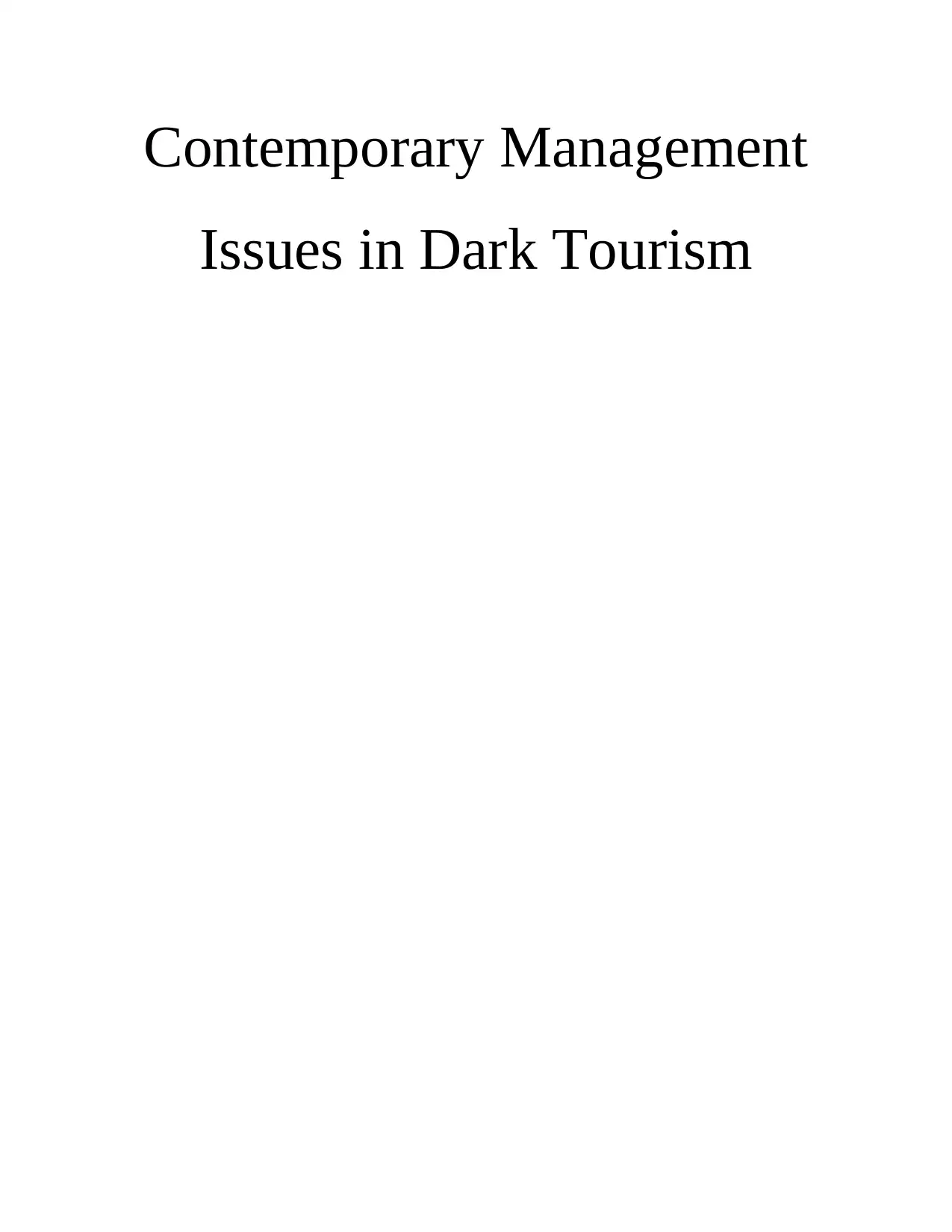
Contemporary Management
Issues in Dark Tourism
Issues in Dark Tourism
Paraphrase This Document
Need a fresh take? Get an instant paraphrase of this document with our AI Paraphraser
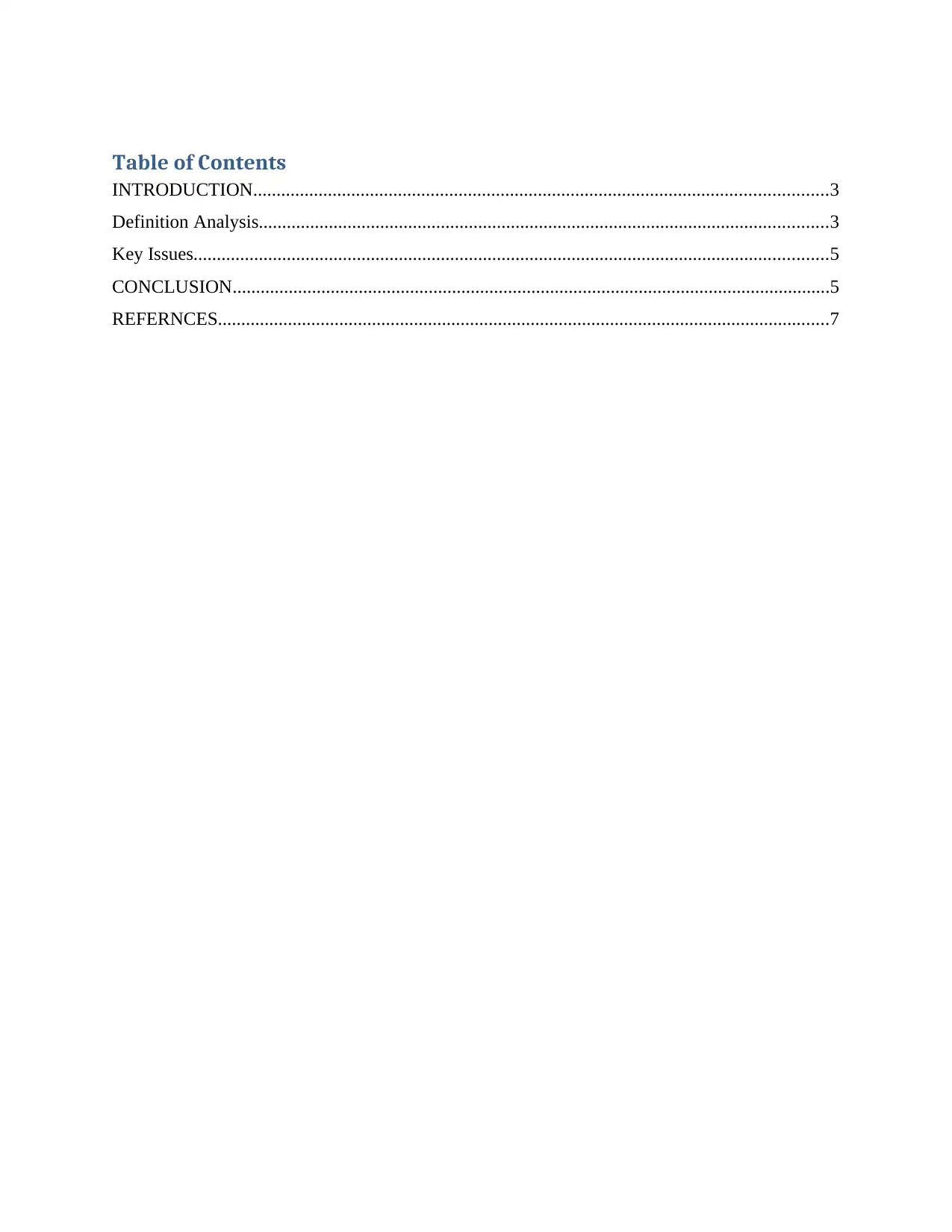
Table of Contents
INTRODUCTION...........................................................................................................................3
Definition Analysis..........................................................................................................................3
Key Issues........................................................................................................................................5
CONCLUSION................................................................................................................................5
REFERNCES...................................................................................................................................7
INTRODUCTION...........................................................................................................................3
Definition Analysis..........................................................................................................................3
Key Issues........................................................................................................................................5
CONCLUSION................................................................................................................................5
REFERNCES...................................................................................................................................7
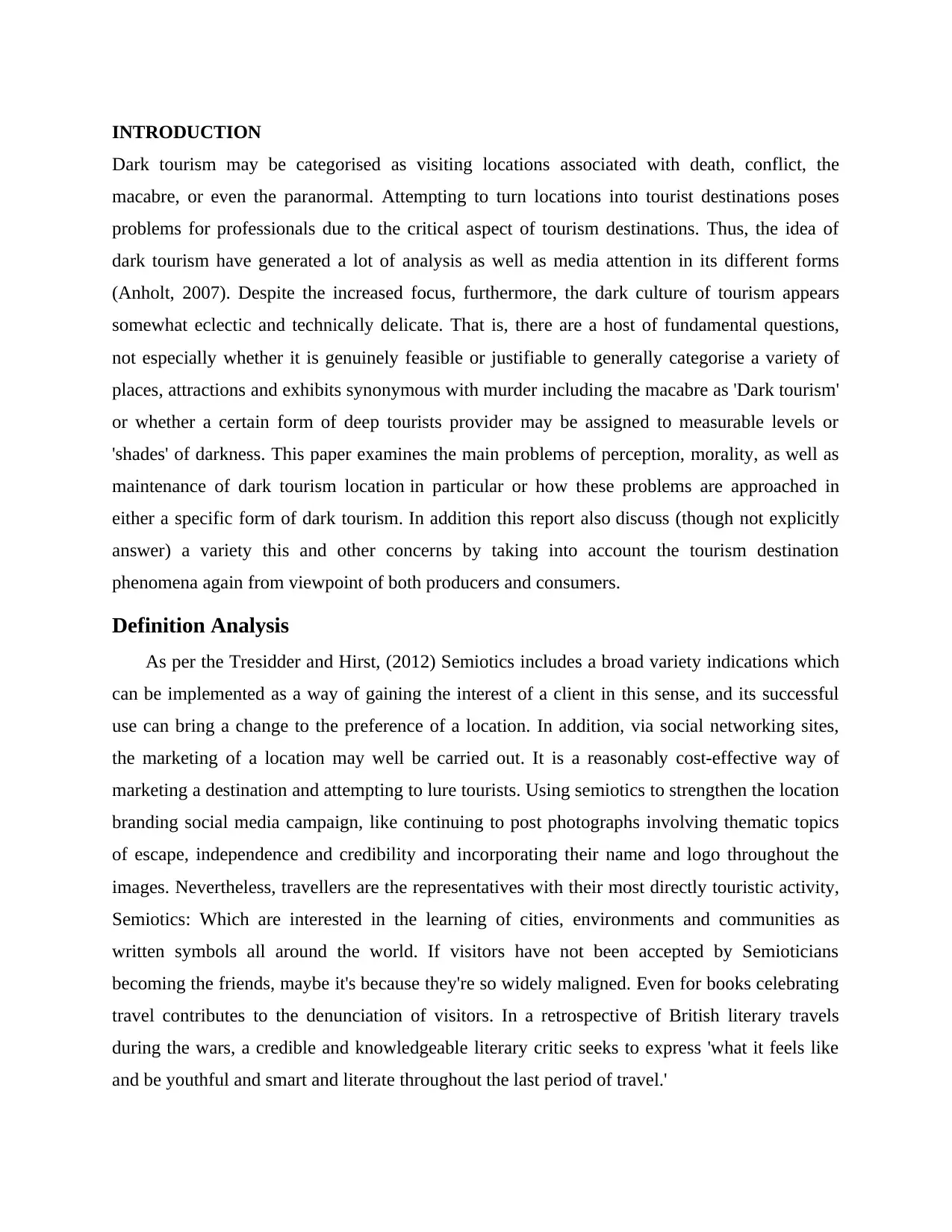
INTRODUCTION
Dark tourism may be categorised as visiting locations associated with death, conflict, the
macabre, or even the paranormal. Attempting to turn locations into tourist destinations poses
problems for professionals due to the critical aspect of tourism destinations. Thus, the idea of
dark tourism have generated a lot of analysis as well as media attention in its different forms
(Anholt, 2007). Despite the increased focus, furthermore, the dark culture of tourism appears
somewhat eclectic and technically delicate. That is, there are a host of fundamental questions,
not especially whether it is genuinely feasible or justifiable to generally categorise a variety of
places, attractions and exhibits synonymous with murder including the macabre as 'Dark tourism'
or whether a certain form of deep tourists provider may be assigned to measurable levels or
'shades' of darkness. This paper examines the main problems of perception, morality, as well as
maintenance of dark tourism location in particular or how these problems are approached in
either a specific form of dark tourism. In addition this report also discuss (though not explicitly
answer) a variety this and other concerns by taking into account the tourism destination
phenomena again from viewpoint of both producers and consumers.
Definition Analysis
As per the Tresidder and Hirst, (2012) Semiotics includes a broad variety indications which
can be implemented as a way of gaining the interest of a client in this sense, and its successful
use can bring a change to the preference of a location. In addition, via social networking sites,
the marketing of a location may well be carried out. It is a reasonably cost-effective way of
marketing a destination and attempting to lure tourists. Using semiotics to strengthen the location
branding social media campaign, like continuing to post photographs involving thematic topics
of escape, independence and credibility and incorporating their name and logo throughout the
images. Nevertheless, travellers are the representatives with their most directly touristic activity,
Semiotics: Which are interested in the learning of cities, environments and communities as
written symbols all around the world. If visitors have not been accepted by Semioticians
becoming the friends, maybe it's because they're so widely maligned. Even for books celebrating
travel contributes to the denunciation of visitors. In a retrospective of British literary travels
during the wars, a credible and knowledgeable literary critic seeks to express 'what it feels like
and be youthful and smart and literate throughout the last period of travel.'
Dark tourism may be categorised as visiting locations associated with death, conflict, the
macabre, or even the paranormal. Attempting to turn locations into tourist destinations poses
problems for professionals due to the critical aspect of tourism destinations. Thus, the idea of
dark tourism have generated a lot of analysis as well as media attention in its different forms
(Anholt, 2007). Despite the increased focus, furthermore, the dark culture of tourism appears
somewhat eclectic and technically delicate. That is, there are a host of fundamental questions,
not especially whether it is genuinely feasible or justifiable to generally categorise a variety of
places, attractions and exhibits synonymous with murder including the macabre as 'Dark tourism'
or whether a certain form of deep tourists provider may be assigned to measurable levels or
'shades' of darkness. This paper examines the main problems of perception, morality, as well as
maintenance of dark tourism location in particular or how these problems are approached in
either a specific form of dark tourism. In addition this report also discuss (though not explicitly
answer) a variety this and other concerns by taking into account the tourism destination
phenomena again from viewpoint of both producers and consumers.
Definition Analysis
As per the Tresidder and Hirst, (2012) Semiotics includes a broad variety indications which
can be implemented as a way of gaining the interest of a client in this sense, and its successful
use can bring a change to the preference of a location. In addition, via social networking sites,
the marketing of a location may well be carried out. It is a reasonably cost-effective way of
marketing a destination and attempting to lure tourists. Using semiotics to strengthen the location
branding social media campaign, like continuing to post photographs involving thematic topics
of escape, independence and credibility and incorporating their name and logo throughout the
images. Nevertheless, travellers are the representatives with their most directly touristic activity,
Semiotics: Which are interested in the learning of cities, environments and communities as
written symbols all around the world. If visitors have not been accepted by Semioticians
becoming the friends, maybe it's because they're so widely maligned. Even for books celebrating
travel contributes to the denunciation of visitors. In a retrospective of British literary travels
during the wars, a credible and knowledgeable literary critic seeks to express 'what it feels like
and be youthful and smart and literate throughout the last period of travel.'
⊘ This is a preview!⊘
Do you want full access?
Subscribe today to unlock all pages.

Trusted by 1+ million students worldwide
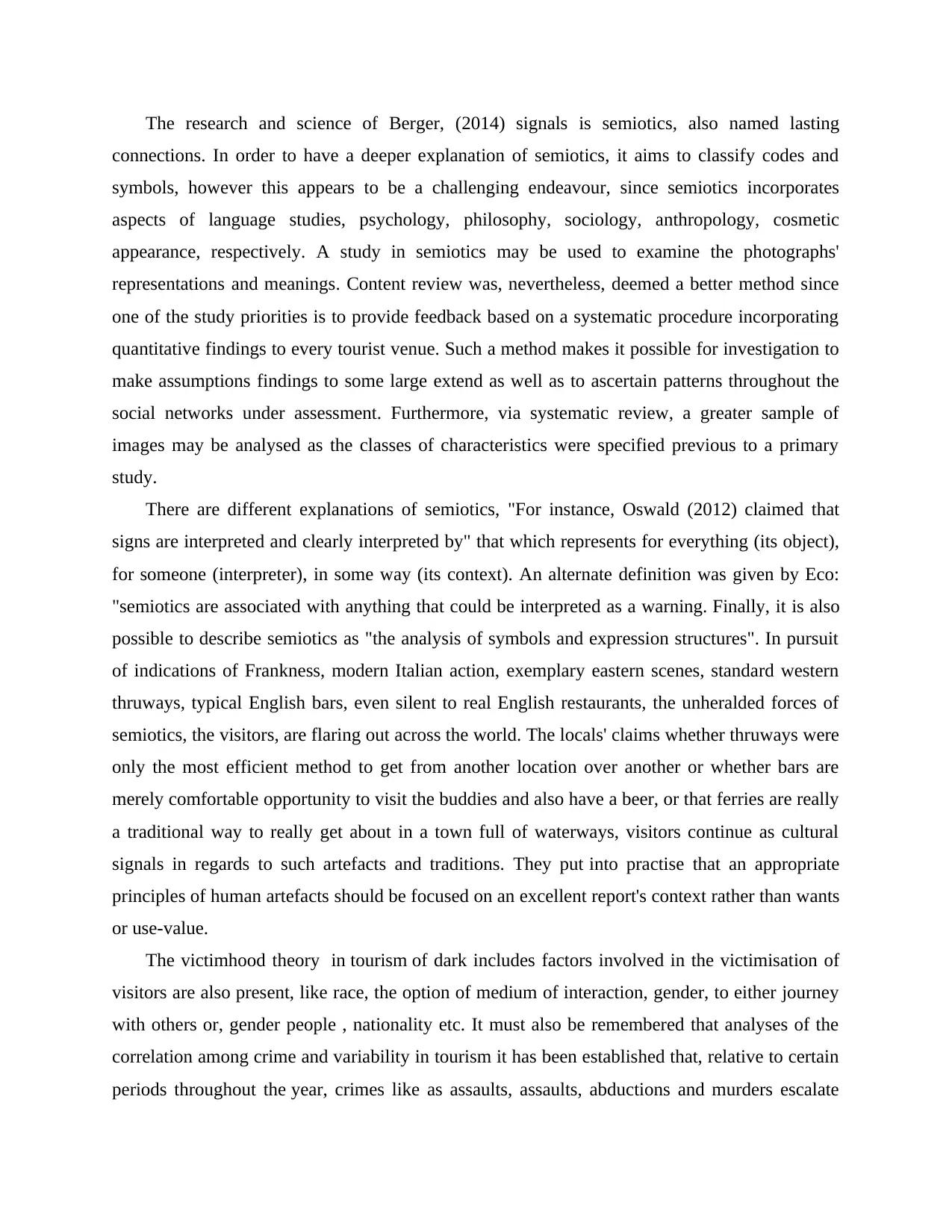
The research and science of Berger, (2014) signals is semiotics, also named lasting
connections. In order to have a deeper explanation of semiotics, it aims to classify codes and
symbols, however this appears to be a challenging endeavour, since semiotics incorporates
aspects of language studies, psychology, philosophy, sociology, anthropology, cosmetic
appearance, respectively. A study in semiotics may be used to examine the photographs'
representations and meanings. Content review was, nevertheless, deemed a better method since
one of the study priorities is to provide feedback based on a systematic procedure incorporating
quantitative findings to every tourist venue. Such a method makes it possible for investigation to
make assumptions findings to some large extend as well as to ascertain patterns throughout the
social networks under assessment. Furthermore, via systematic review, a greater sample of
images may be analysed as the classes of characteristics were specified previous to a primary
study.
There are different explanations of semiotics, "For instance, Oswald (2012) claimed that
signs are interpreted and clearly interpreted by" that which represents for everything (its object),
for someone (interpreter), in some way (its context). An alternate definition was given by Eco:
"semiotics are associated with anything that could be interpreted as a warning. Finally, it is also
possible to describe semiotics as "the analysis of symbols and expression structures". In pursuit
of indications of Frankness, modern Italian action, exemplary eastern scenes, standard western
thruways, typical English bars, even silent to real English restaurants, the unheralded forces of
semiotics, the visitors, are flaring out across the world. The locals' claims whether thruways were
only the most efficient method to get from another location over another or whether bars are
merely comfortable opportunity to visit the buddies and also have a beer, or that ferries are really
a traditional way to really get about in a town full of waterways, visitors continue as cultural
signals in regards to such artefacts and traditions. They put into practise that an appropriate
principles of human artefacts should be focused on an excellent report's context rather than wants
or use-value.
The victimhood theory in tourism of dark includes factors involved in the victimisation of
visitors are also present, like race, the option of medium of interaction, gender, to either journey
with others or, gender people , nationality etc. It must also be remembered that analyses of the
correlation among crime and variability in tourism it has been established that, relative to certain
periods throughout the year, crimes like as assaults, assaults, abductions and murders escalate
connections. In order to have a deeper explanation of semiotics, it aims to classify codes and
symbols, however this appears to be a challenging endeavour, since semiotics incorporates
aspects of language studies, psychology, philosophy, sociology, anthropology, cosmetic
appearance, respectively. A study in semiotics may be used to examine the photographs'
representations and meanings. Content review was, nevertheless, deemed a better method since
one of the study priorities is to provide feedback based on a systematic procedure incorporating
quantitative findings to every tourist venue. Such a method makes it possible for investigation to
make assumptions findings to some large extend as well as to ascertain patterns throughout the
social networks under assessment. Furthermore, via systematic review, a greater sample of
images may be analysed as the classes of characteristics were specified previous to a primary
study.
There are different explanations of semiotics, "For instance, Oswald (2012) claimed that
signs are interpreted and clearly interpreted by" that which represents for everything (its object),
for someone (interpreter), in some way (its context). An alternate definition was given by Eco:
"semiotics are associated with anything that could be interpreted as a warning. Finally, it is also
possible to describe semiotics as "the analysis of symbols and expression structures". In pursuit
of indications of Frankness, modern Italian action, exemplary eastern scenes, standard western
thruways, typical English bars, even silent to real English restaurants, the unheralded forces of
semiotics, the visitors, are flaring out across the world. The locals' claims whether thruways were
only the most efficient method to get from another location over another or whether bars are
merely comfortable opportunity to visit the buddies and also have a beer, or that ferries are really
a traditional way to really get about in a town full of waterways, visitors continue as cultural
signals in regards to such artefacts and traditions. They put into practise that an appropriate
principles of human artefacts should be focused on an excellent report's context rather than wants
or use-value.
The victimhood theory in tourism of dark includes factors involved in the victimisation of
visitors are also present, like race, the option of medium of interaction, gender, to either journey
with others or, gender people , nationality etc. It must also be remembered that analyses of the
correlation among crime and variability in tourism it has been established that, relative to certain
periods throughout the year, crimes like as assaults, assaults, abductions and murders escalate
Paraphrase This Document
Need a fresh take? Get an instant paraphrase of this document with our AI Paraphraser
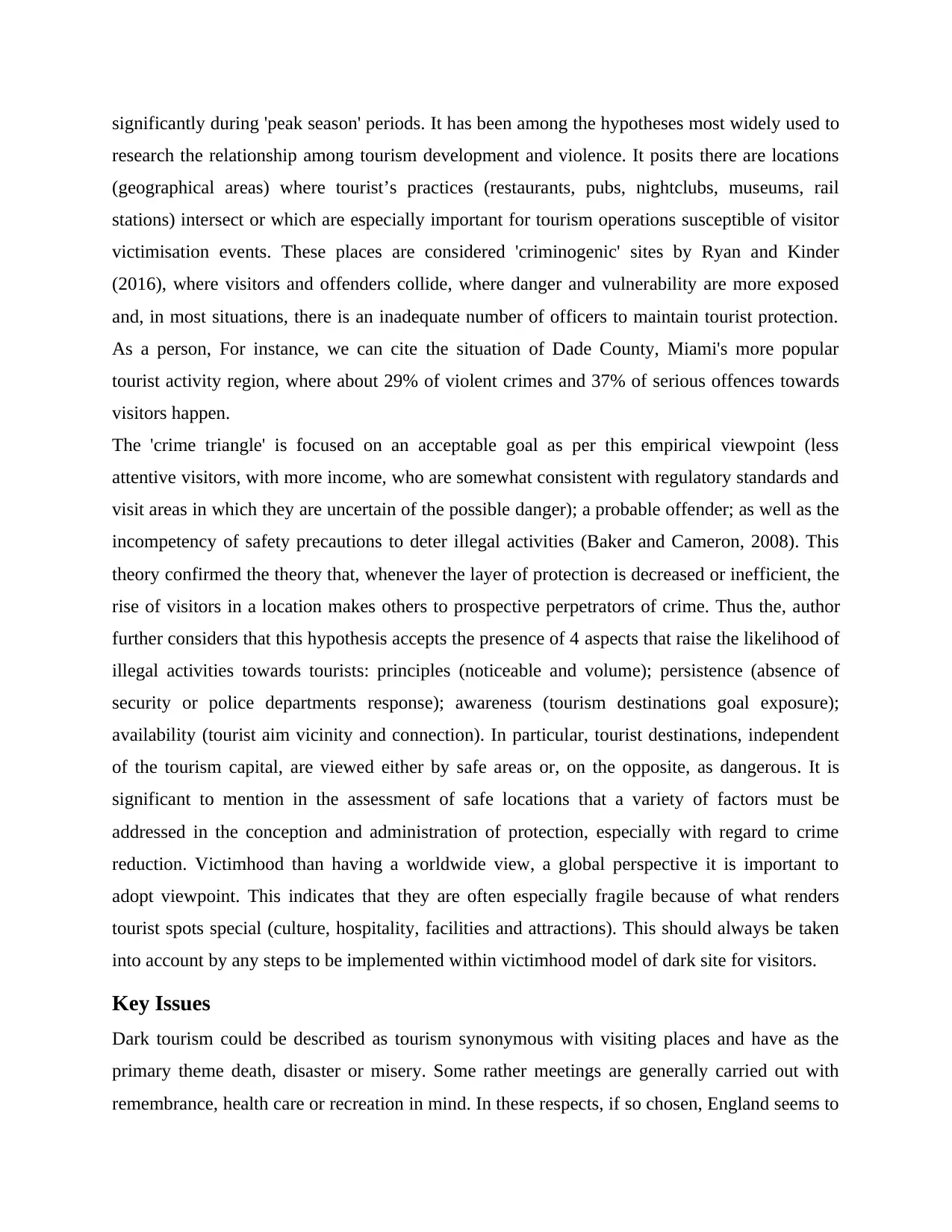
significantly during 'peak season' periods. It has been among the hypotheses most widely used to
research the relationship among tourism development and violence. It posits there are locations
(geographical areas) where tourist’s practices (restaurants, pubs, nightclubs, museums, rail
stations) intersect or which are especially important for tourism operations susceptible of visitor
victimisation events. These places are considered 'criminogenic' sites by Ryan and Kinder
(2016), where visitors and offenders collide, where danger and vulnerability are more exposed
and, in most situations, there is an inadequate number of officers to maintain tourist protection.
As a person, For instance, we can cite the situation of Dade County, Miami's more popular
tourist activity region, where about 29% of violent crimes and 37% of serious offences towards
visitors happen.
The 'crime triangle' is focused on an acceptable goal as per this empirical viewpoint (less
attentive visitors, with more income, who are somewhat consistent with regulatory standards and
visit areas in which they are uncertain of the possible danger); a probable offender; as well as the
incompetency of safety precautions to deter illegal activities (Baker and Cameron, 2008). This
theory confirmed the theory that, whenever the layer of protection is decreased or inefficient, the
rise of visitors in a location makes others to prospective perpetrators of crime. Thus the, author
further considers that this hypothesis accepts the presence of 4 aspects that raise the likelihood of
illegal activities towards tourists: principles (noticeable and volume); persistence (absence of
security or police departments response); awareness (tourism destinations goal exposure);
availability (tourist aim vicinity and connection). In particular, tourist destinations, independent
of the tourism capital, are viewed either by safe areas or, on the opposite, as dangerous. It is
significant to mention in the assessment of safe locations that a variety of factors must be
addressed in the conception and administration of protection, especially with regard to crime
reduction. Victimhood than having a worldwide view, a global perspective it is important to
adopt viewpoint. This indicates that they are often especially fragile because of what renders
tourist spots special (culture, hospitality, facilities and attractions). This should always be taken
into account by any steps to be implemented within victimhood model of dark site for visitors.
Key Issues
Dark tourism could be described as tourism synonymous with visiting places and have as the
primary theme death, disaster or misery. Some rather meetings are generally carried out with
remembrance, health care or recreation in mind. In these respects, if so chosen, England seems to
research the relationship among tourism development and violence. It posits there are locations
(geographical areas) where tourist’s practices (restaurants, pubs, nightclubs, museums, rail
stations) intersect or which are especially important for tourism operations susceptible of visitor
victimisation events. These places are considered 'criminogenic' sites by Ryan and Kinder
(2016), where visitors and offenders collide, where danger and vulnerability are more exposed
and, in most situations, there is an inadequate number of officers to maintain tourist protection.
As a person, For instance, we can cite the situation of Dade County, Miami's more popular
tourist activity region, where about 29% of violent crimes and 37% of serious offences towards
visitors happen.
The 'crime triangle' is focused on an acceptable goal as per this empirical viewpoint (less
attentive visitors, with more income, who are somewhat consistent with regulatory standards and
visit areas in which they are uncertain of the possible danger); a probable offender; as well as the
incompetency of safety precautions to deter illegal activities (Baker and Cameron, 2008). This
theory confirmed the theory that, whenever the layer of protection is decreased or inefficient, the
rise of visitors in a location makes others to prospective perpetrators of crime. Thus the, author
further considers that this hypothesis accepts the presence of 4 aspects that raise the likelihood of
illegal activities towards tourists: principles (noticeable and volume); persistence (absence of
security or police departments response); awareness (tourism destinations goal exposure);
availability (tourist aim vicinity and connection). In particular, tourist destinations, independent
of the tourism capital, are viewed either by safe areas or, on the opposite, as dangerous. It is
significant to mention in the assessment of safe locations that a variety of factors must be
addressed in the conception and administration of protection, especially with regard to crime
reduction. Victimhood than having a worldwide view, a global perspective it is important to
adopt viewpoint. This indicates that they are often especially fragile because of what renders
tourist spots special (culture, hospitality, facilities and attractions). This should always be taken
into account by any steps to be implemented within victimhood model of dark site for visitors.
Key Issues
Dark tourism could be described as tourism synonymous with visiting places and have as the
primary theme death, disaster or misery. Some rather meetings are generally carried out with
remembrance, health care or recreation in mind. In these respects, if so chosen, England seems to
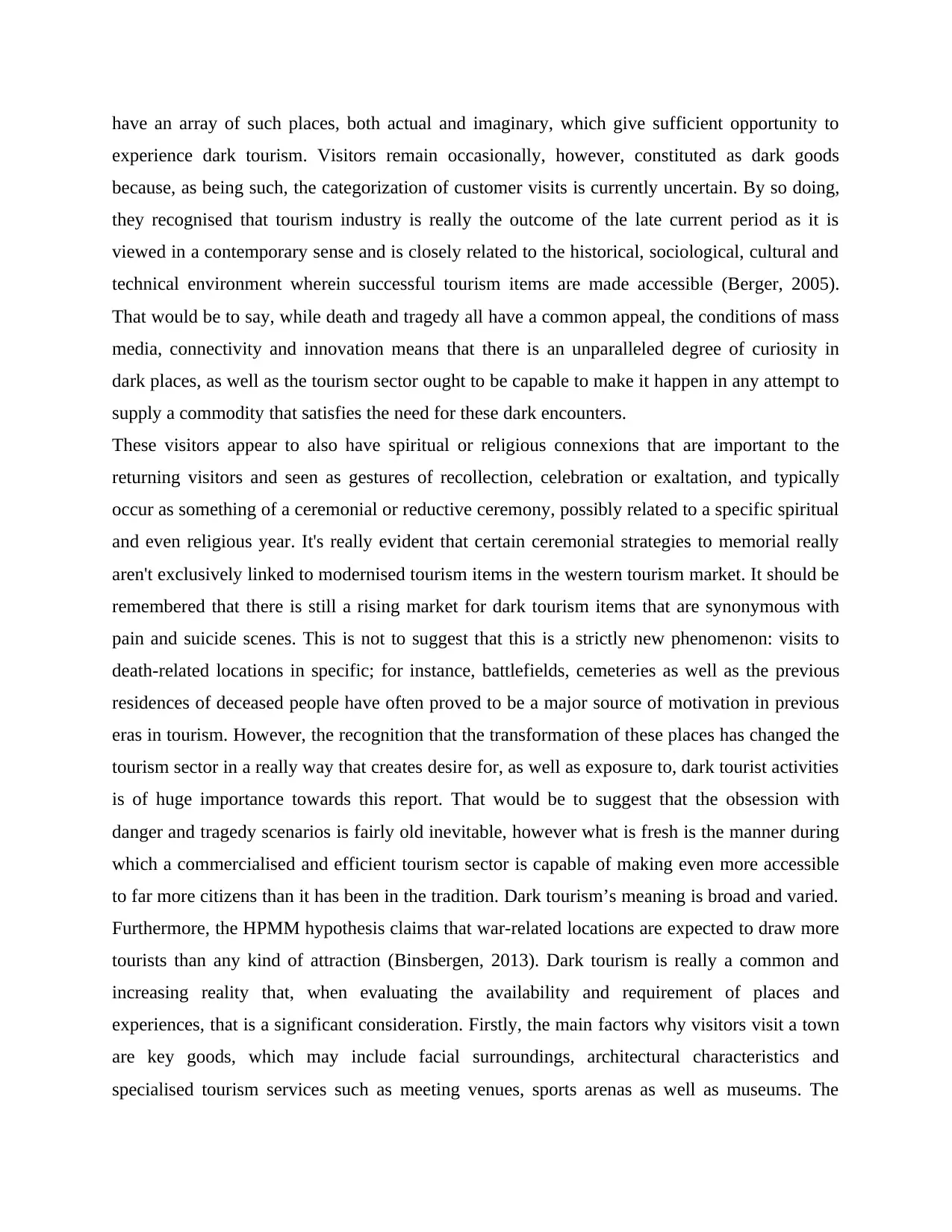
have an array of such places, both actual and imaginary, which give sufficient opportunity to
experience dark tourism. Visitors remain occasionally, however, constituted as dark goods
because, as being such, the categorization of customer visits is currently uncertain. By so doing,
they recognised that tourism industry is really the outcome of the late current period as it is
viewed in a contemporary sense and is closely related to the historical, sociological, cultural and
technical environment wherein successful tourism items are made accessible (Berger, 2005).
That would be to say, while death and tragedy all have a common appeal, the conditions of mass
media, connectivity and innovation means that there is an unparalleled degree of curiosity in
dark places, as well as the tourism sector ought to be capable to make it happen in any attempt to
supply a commodity that satisfies the need for these dark encounters.
These visitors appear to also have spiritual or religious connexions that are important to the
returning visitors and seen as gestures of recollection, celebration or exaltation, and typically
occur as something of a ceremonial or reductive ceremony, possibly related to a specific spiritual
and even religious year. It's really evident that certain ceremonial strategies to memorial really
aren't exclusively linked to modernised tourism items in the western tourism market. It should be
remembered that there is still a rising market for dark tourism items that are synonymous with
pain and suicide scenes. This is not to suggest that this is a strictly new phenomenon: visits to
death-related locations in specific; for instance, battlefields, cemeteries as well as the previous
residences of deceased people have often proved to be a major source of motivation in previous
eras in tourism. However, the recognition that the transformation of these places has changed the
tourism sector in a really way that creates desire for, as well as exposure to, dark tourist activities
is of huge importance towards this report. That would be to suggest that the obsession with
danger and tragedy scenarios is fairly old inevitable, however what is fresh is the manner during
which a commercialised and efficient tourism sector is capable of making even more accessible
to far more citizens than it has been in the tradition. Dark tourism’s meaning is broad and varied.
Furthermore, the HPMM hypothesis claims that war-related locations are expected to draw more
tourists than any kind of attraction (Binsbergen, 2013). Dark tourism is really a common and
increasing reality that, when evaluating the availability and requirement of places and
experiences, that is a significant consideration. Firstly, the main factors why visitors visit a town
are key goods, which may include facial surroundings, architectural characteristics and
specialised tourism services such as meeting venues, sports arenas as well as museums. The
experience dark tourism. Visitors remain occasionally, however, constituted as dark goods
because, as being such, the categorization of customer visits is currently uncertain. By so doing,
they recognised that tourism industry is really the outcome of the late current period as it is
viewed in a contemporary sense and is closely related to the historical, sociological, cultural and
technical environment wherein successful tourism items are made accessible (Berger, 2005).
That would be to say, while death and tragedy all have a common appeal, the conditions of mass
media, connectivity and innovation means that there is an unparalleled degree of curiosity in
dark places, as well as the tourism sector ought to be capable to make it happen in any attempt to
supply a commodity that satisfies the need for these dark encounters.
These visitors appear to also have spiritual or religious connexions that are important to the
returning visitors and seen as gestures of recollection, celebration or exaltation, and typically
occur as something of a ceremonial or reductive ceremony, possibly related to a specific spiritual
and even religious year. It's really evident that certain ceremonial strategies to memorial really
aren't exclusively linked to modernised tourism items in the western tourism market. It should be
remembered that there is still a rising market for dark tourism items that are synonymous with
pain and suicide scenes. This is not to suggest that this is a strictly new phenomenon: visits to
death-related locations in specific; for instance, battlefields, cemeteries as well as the previous
residences of deceased people have often proved to be a major source of motivation in previous
eras in tourism. However, the recognition that the transformation of these places has changed the
tourism sector in a really way that creates desire for, as well as exposure to, dark tourist activities
is of huge importance towards this report. That would be to suggest that the obsession with
danger and tragedy scenarios is fairly old inevitable, however what is fresh is the manner during
which a commercialised and efficient tourism sector is capable of making even more accessible
to far more citizens than it has been in the tradition. Dark tourism’s meaning is broad and varied.
Furthermore, the HPMM hypothesis claims that war-related locations are expected to draw more
tourists than any kind of attraction (Binsbergen, 2013). Dark tourism is really a common and
increasing reality that, when evaluating the availability and requirement of places and
experiences, that is a significant consideration. Firstly, the main factors why visitors visit a town
are key goods, which may include facial surroundings, architectural characteristics and
specialised tourism services such as meeting venues, sports arenas as well as museums. The
⊘ This is a preview!⊘
Do you want full access?
Subscribe today to unlock all pages.

Trusted by 1+ million students worldwide
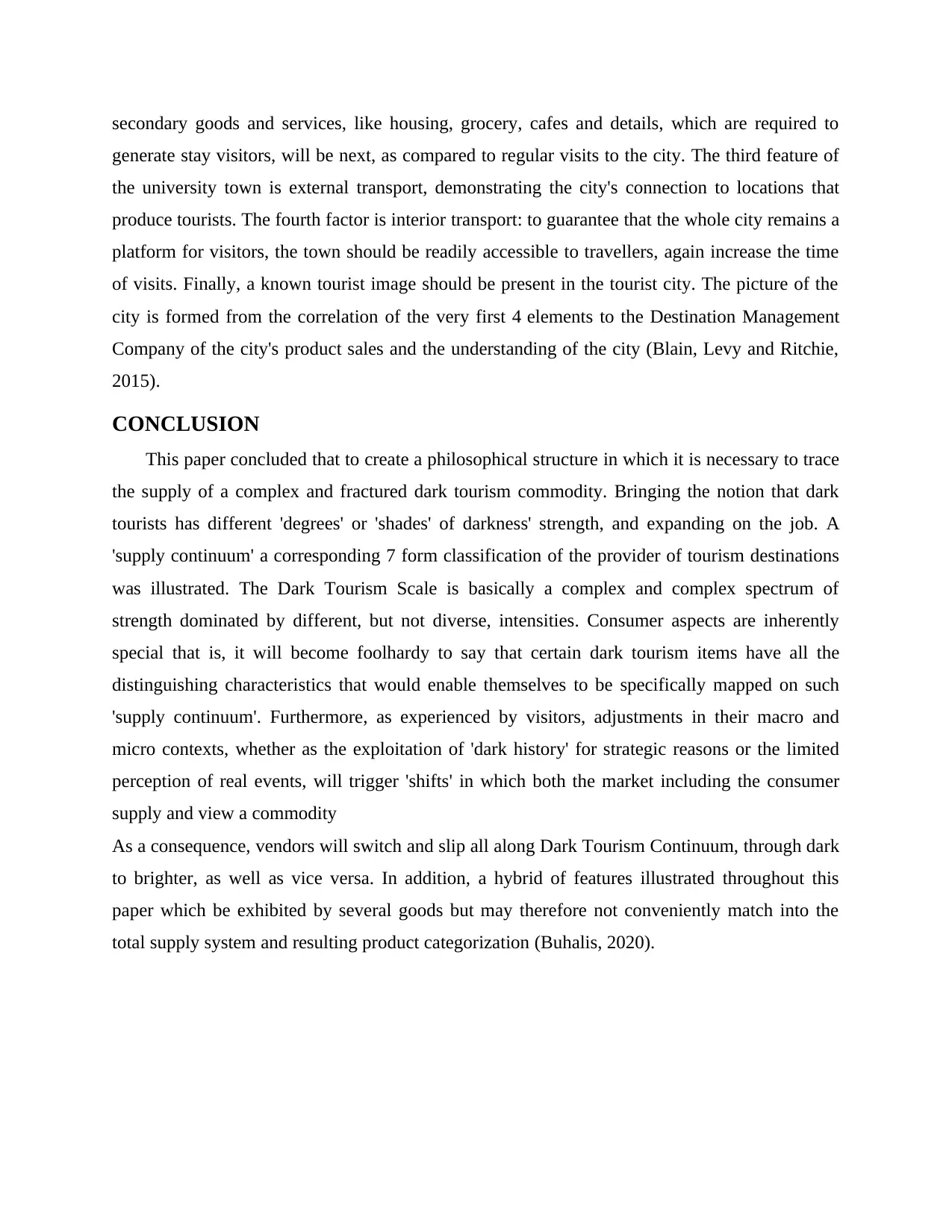
secondary goods and services, like housing, grocery, cafes and details, which are required to
generate stay visitors, will be next, as compared to regular visits to the city. The third feature of
the university town is external transport, demonstrating the city's connection to locations that
produce tourists. The fourth factor is interior transport: to guarantee that the whole city remains a
platform for visitors, the town should be readily accessible to travellers, again increase the time
of visits. Finally, a known tourist image should be present in the tourist city. The picture of the
city is formed from the correlation of the very first 4 elements to the Destination Management
Company of the city's product sales and the understanding of the city (Blain, Levy and Ritchie,
2015).
CONCLUSION
This paper concluded that to create a philosophical structure in which it is necessary to trace
the supply of a complex and fractured dark tourism commodity. Bringing the notion that dark
tourists has different 'degrees' or 'shades' of darkness' strength, and expanding on the job. A
'supply continuum' a corresponding 7 form classification of the provider of tourism destinations
was illustrated. The Dark Tourism Scale is basically a complex and complex spectrum of
strength dominated by different, but not diverse, intensities. Consumer aspects are inherently
special that is, it will become foolhardy to say that certain dark tourism items have all the
distinguishing characteristics that would enable themselves to be specifically mapped on such
'supply continuum'. Furthermore, as experienced by visitors, adjustments in their macro and
micro contexts, whether as the exploitation of 'dark history' for strategic reasons or the limited
perception of real events, will trigger 'shifts' in which both the market including the consumer
supply and view a commodity
As a consequence, vendors will switch and slip all along Dark Tourism Continuum, through dark
to brighter, as well as vice versa. In addition, a hybrid of features illustrated throughout this
paper which be exhibited by several goods but may therefore not conveniently match into the
total supply system and resulting product categorization (Buhalis, 2020).
generate stay visitors, will be next, as compared to regular visits to the city. The third feature of
the university town is external transport, demonstrating the city's connection to locations that
produce tourists. The fourth factor is interior transport: to guarantee that the whole city remains a
platform for visitors, the town should be readily accessible to travellers, again increase the time
of visits. Finally, a known tourist image should be present in the tourist city. The picture of the
city is formed from the correlation of the very first 4 elements to the Destination Management
Company of the city's product sales and the understanding of the city (Blain, Levy and Ritchie,
2015).
CONCLUSION
This paper concluded that to create a philosophical structure in which it is necessary to trace
the supply of a complex and fractured dark tourism commodity. Bringing the notion that dark
tourists has different 'degrees' or 'shades' of darkness' strength, and expanding on the job. A
'supply continuum' a corresponding 7 form classification of the provider of tourism destinations
was illustrated. The Dark Tourism Scale is basically a complex and complex spectrum of
strength dominated by different, but not diverse, intensities. Consumer aspects are inherently
special that is, it will become foolhardy to say that certain dark tourism items have all the
distinguishing characteristics that would enable themselves to be specifically mapped on such
'supply continuum'. Furthermore, as experienced by visitors, adjustments in their macro and
micro contexts, whether as the exploitation of 'dark history' for strategic reasons or the limited
perception of real events, will trigger 'shifts' in which both the market including the consumer
supply and view a commodity
As a consequence, vendors will switch and slip all along Dark Tourism Continuum, through dark
to brighter, as well as vice versa. In addition, a hybrid of features illustrated throughout this
paper which be exhibited by several goods but may therefore not conveniently match into the
total supply system and resulting product categorization (Buhalis, 2020).
Paraphrase This Document
Need a fresh take? Get an instant paraphrase of this document with our AI Paraphraser
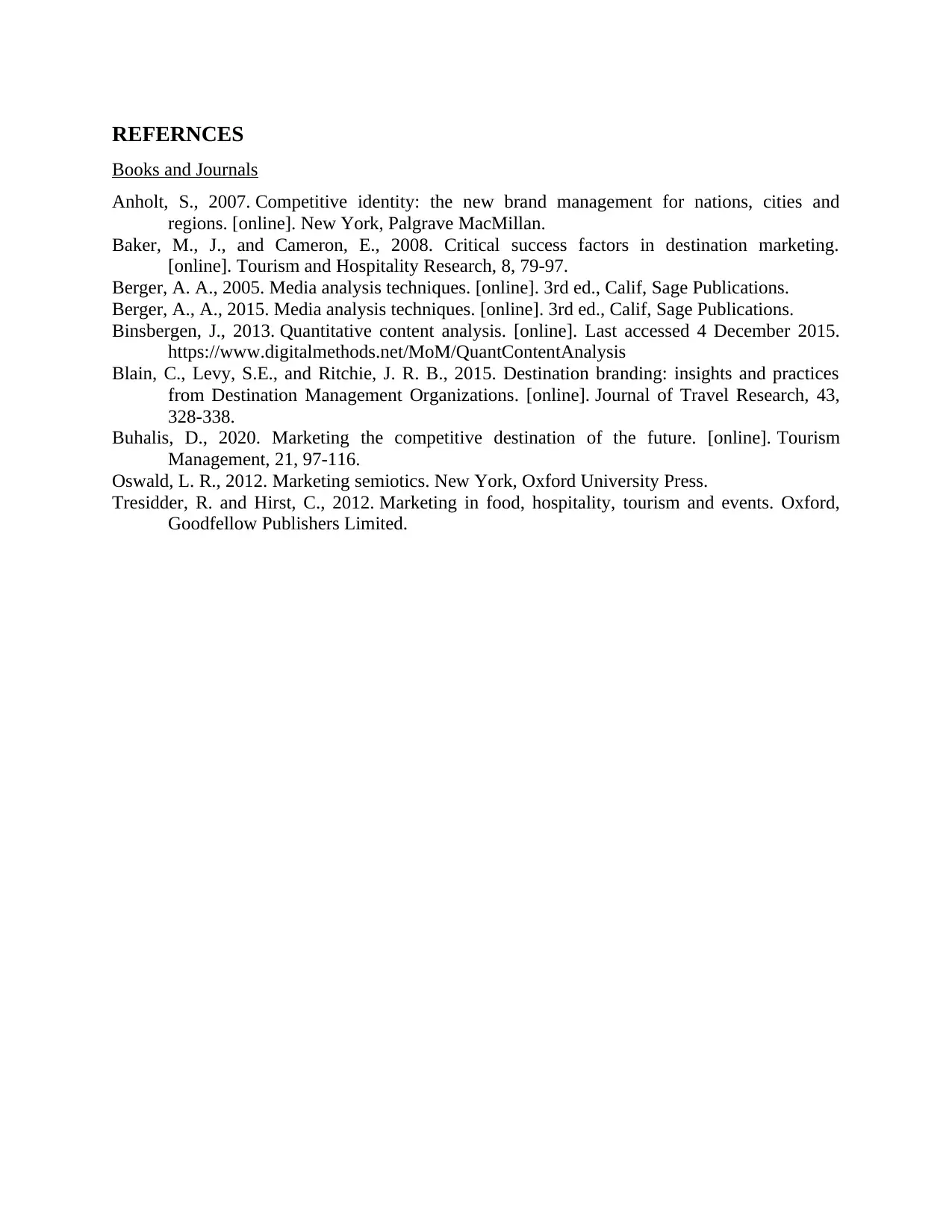
REFERNCES
Books and Journals
Anholt, S., 2007. Competitive identity: the new brand management for nations, cities and
regions. [online]. New York, Palgrave MacMillan.
Baker, M., J., and Cameron, E., 2008. Critical success factors in destination marketing.
[online]. Tourism and Hospitality Research, 8, 79-97.
Berger, A. A., 2005. Media analysis techniques. [online]. 3rd ed., Calif, Sage Publications.
Berger, A., A., 2015. Media analysis techniques. [online]. 3rd ed., Calif, Sage Publications.
Binsbergen, J., 2013. Quantitative content analysis. [online]. Last accessed 4 December 2015.
https://www.digitalmethods.net/MoM/QuantContentAnalysis
Blain, C., Levy, S.E., and Ritchie, J. R. B., 2015. Destination branding: insights and practices
from Destination Management Organizations. [online]. Journal of Travel Research, 43,
328-338.
Buhalis, D., 2020. Marketing the competitive destination of the future. [online]. Tourism
Management, 21, 97-116.
Oswald, L. R., 2012. Marketing semiotics. New York, Oxford University Press.
Tresidder, R. and Hirst, C., 2012. Marketing in food, hospitality, tourism and events. Oxford,
Goodfellow Publishers Limited.
Books and Journals
Anholt, S., 2007. Competitive identity: the new brand management for nations, cities and
regions. [online]. New York, Palgrave MacMillan.
Baker, M., J., and Cameron, E., 2008. Critical success factors in destination marketing.
[online]. Tourism and Hospitality Research, 8, 79-97.
Berger, A. A., 2005. Media analysis techniques. [online]. 3rd ed., Calif, Sage Publications.
Berger, A., A., 2015. Media analysis techniques. [online]. 3rd ed., Calif, Sage Publications.
Binsbergen, J., 2013. Quantitative content analysis. [online]. Last accessed 4 December 2015.
https://www.digitalmethods.net/MoM/QuantContentAnalysis
Blain, C., Levy, S.E., and Ritchie, J. R. B., 2015. Destination branding: insights and practices
from Destination Management Organizations. [online]. Journal of Travel Research, 43,
328-338.
Buhalis, D., 2020. Marketing the competitive destination of the future. [online]. Tourism
Management, 21, 97-116.
Oswald, L. R., 2012. Marketing semiotics. New York, Oxford University Press.
Tresidder, R. and Hirst, C., 2012. Marketing in food, hospitality, tourism and events. Oxford,
Goodfellow Publishers Limited.
1 out of 8
Your All-in-One AI-Powered Toolkit for Academic Success.
+13062052269
info@desklib.com
Available 24*7 on WhatsApp / Email
![[object Object]](/_next/static/media/star-bottom.7253800d.svg)
Unlock your academic potential
Copyright © 2020–2025 A2Z Services. All Rights Reserved. Developed and managed by ZUCOL.